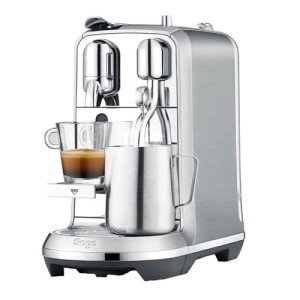Heat Exchange Espresso Machines: A Comprehensive Guide
Espresso machines have actually progressed substantially over the years, catering to the needs of home baristas and coffee specialists alike. Amongst these machines, heat exchange espresso machines have gotten appeal due to their capability to deliver consistent efficiency and remarkable brew quality. In this post, we will explore the workings, advantages, and essential functions of heat exchange espresso machines, providing an extensive understanding for both potential buyers and coffee enthusiasts.
Comprehending Heat Exchange Technology
Heat exchange espresso machines run on an unique principle that enables simultaneous water heating for developing and steaming. They are equipped with a single boiler that utilizes a heat exchanger system. This function is substantial as it allows users to brew espresso while steaming milk simultaneously, promoting performance in the coffee-making process.
How Does a Heat Exchange Espresso Machine Work?
The process starts with the machine's water inlet filling the boiler. As the water warms up, it turns to steam. Espresso Maker Online utilizes hot steam to heat additional water in a different passage developed specifically for the brew group. This indicates that water can reach the perfect brewing temperature level without awaiting the boiler to adjust. The crucial steps consist of:
- Water Fill: Water is drawn into the boiler.
- Heating Process: The boiler heats up as water is converted into steam.
- Heat Exchange: Steam heats water in the heat exchanger tube.
- Developing: Water from the heat exchanger is pressed through coffee grounds, drawing out the flavors required for an abundant espresso.
This process allows for quick temperature level adjustments and enhanced coffee extraction.
Advantages of Heat Exchange Espresso Machines
Heat exchange espresso machines use numerous benefits, especially for those looking to maximize their coffee experience. Here are some key advantages:
- Simultaneous Brewing and Steaming: Users can brew espresso while steaming milk, making it perfect for hectic coffee shops and home baristas who value efficiency.
- Temperature level Stability: The boiler's steam pressure helps maintain a stable temperature, which is important for constant espresso extraction.
- Flexibility: The style enables fast changing in between brewing and steaming, making it much easier to develop various coffee beverages, from lattes to cappuccinos.
- Easy to use: Models frequently come with accessible controls, making it practical for both beginners and skilled baristas to produce quality beverages.
- Professional Quality: Heat exchange machines are typically used in commercial settings, offering users with high-quality brewing efficiency in the house.
Key Features to Look for in Heat Exchange Espresso Machines
When considering the purchase of a heat exchange espresso machine, there are a number of features that a person should consider:
- Build Quality: Look for machines made from durable materials, such as stainless steel or brass, guaranteeing durability.
- Boiler Size: A larger boiler will hold more water and sustain greater output in time.
- PID Temperature Control: This function assists keep consistent brew temperature levels, which can improve the coffee-making procedure.
- Group Head Design: Machines with a saturated or semi-saturated group head offer better temperature level stability.
- Relieve of Use: User-friendly user interfaces and intuitive controls boost the total experience for baristas at all ability levels.
- Steam Wand Quality: An excellent steam wand with correct insulation and versatility allows for better texturing of milk.
- Water Reservoir Size: Depending on your needs, think about how frequently you wish to fill up the water tank.
Comparison of Popular Heat Exchange Espresso Machines
To much better comprehend the options readily available in the market, below is a comparison table of some popular heat exchange espresso machines:
| Machine Model | Boiler Size | PID Control | Rate Range | User Ratings |
|---|---|---|---|---|
| Profitec Pro 700 | 2.0 L | Yes | ₤ 2,000-₤ 2,500 | 9.5/ 10 |
| Rocket Espresso R58 | 1.8 L | Yes | ₤ 2,400-₤ 2,800 | 9.4/ 10 |
| Elekta Bianca | 1.8 L | Yes | ₤ 2,500-₤ 3,000 | 9.6/ 10 |
| La Spaziale S1 Vivaldi II | 1.5 L | Yes | ₤ 1,800-₤ 2,200 | 9.2/ 10 |
| Bezzera Magica | 1.2 L | No | ₤ 1,600-₤ 1,800 | 9.0/ 10 |
Frequently Asked Questions About Heat Exchange Espresso Machines
What is the primary distinction between a heat exchange and a dual boiler espresso machine?
While both types can brew espresso and steam milk at the exact same time, dual boiler machines have different boilers for developing and steaming. In contrast, heat exchange machines use a single boiler and a heat exchanger to accomplish the exact same function.
Are heat exchange machines appropriate for novices?
Yes! Many heat exchange machines are developed with user-friendly functions, making them available for beginners. With correct assistance and practice, users can quickly produce quality espresso.
What kind of upkeep do heat exchange espresso machines need?
Routine maintenance includes descaling, cleaning the boiler, checking seals and gaskets, and keeping the group head clean. Routine upkeep makes sure durability and consistent performance.
Can I use a heat exchange machine for different kinds of coffee beverages?
Absolutely! Heat exchange machines enable users to develop a variety of coffee beverages, consisting of espresso, lattes, coffees, and more.
Heat exchange espresso machines represent a blend of innovation and tradition, supplying coffee lovers with the tools required for crafting the best cup. Their capability to all at once brew and steam, combined with accurate temperature level control, makes them a compelling option for both home baristas and specialists. With the best knowledge on functions and maintenance, users can open a world of beautiful coffee experiences, ensuring that each sip is as delightful as the last.

